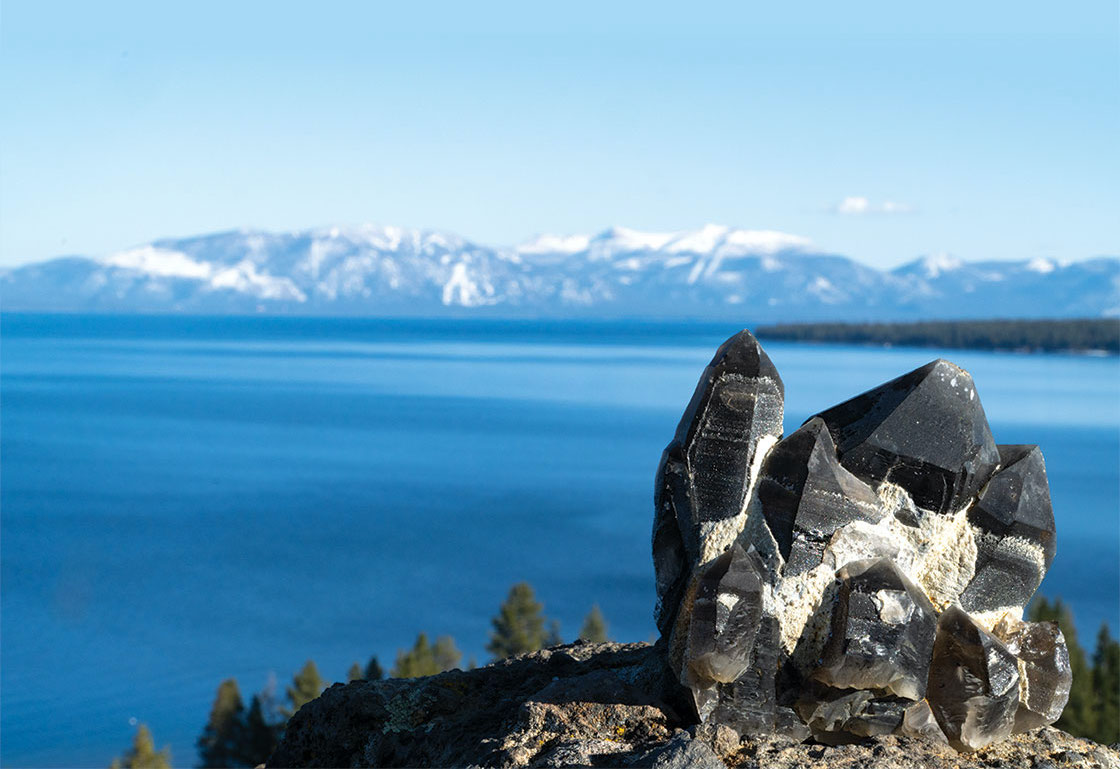
23 Apr The Hunt for Sierra Smokys
Buried treasure and the thrill of the chase inspire Tahoe rockhounds to search for stunning quartz crystals
Most are small, some are big, many are nearly black and a rare few are a rich purple. But no matter their size or color, these coveted specimens are not to be mistaken for your average Tahoe rock.
We’re talking quartz crystals, the functional, spiritual and ever-so-fascinating geological phenomena that just may be hiding in your Tahoe backyard.
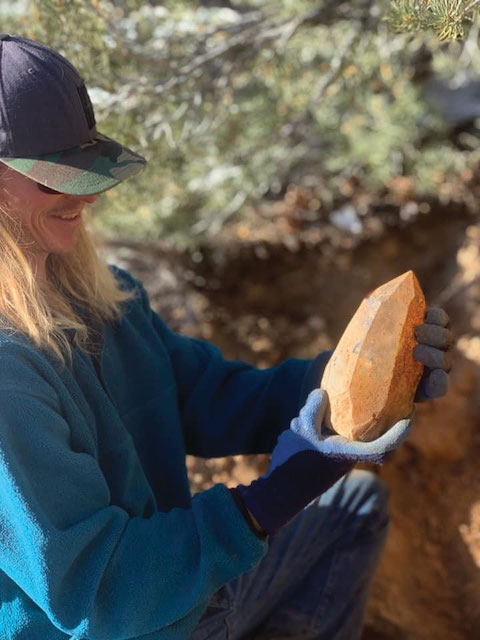
The stoke is real as Teter unearths a fat smoky quartz crystal, photo by Tyler Minnick
Quartz is the second-most abundant mineral in the earth’s crust and is found in many forms. Here in the Sierra, a vast majority of the quartz is locked up as one of the primary mineral ingredients of granite, but not all.
Unbeknownst to many, the Lake Tahoe region produces magnificent quartz crystals, and to a growing group of local rockhounds, digging them up is the thrill of a lifetime.
“Finding crystals is like being a kid on Christmas morning,” says Abe Teter of South Lake Tahoe, a former pro snowboarder turned professional crystal miner. “I’ve been digging for crystals for almost 20 years and I’m still so in love with it. The feeling of finding a crystal is just pure joy and happiness, as you know you are the first person to ever hold this miracle of nature.”
This delight in discovery is also what hooked Ryan Anderson, a veteran crystal hunter from Graeagle who turned a rockhounding hobby into a career as an award-winning lapidary artist and local crystal mine owner.
“There’s just such an innate joy in finding treasure and discovering something that no one else has seen or touched before,” says Anderson. “With how many people there are, and everyone doing everything, there aren’t a lot of things like that left. But when you find a crystal, you feel a genuine thrill of discovery.”
Tahoe’s Signature Specimens
Anderson and Teter are not alone in their quest to uncover Tahoe’s buried crystalline treasures. The area is home to dozens of active crystal diggers and hundreds of enthusiastic rockhounds. So how do you get in on the hunt?
The first step is understanding what crystals can be found in the Tahoe area and the basic geology behind where they can be found. Because even within the region, crystal occurrences are highly variable by location.
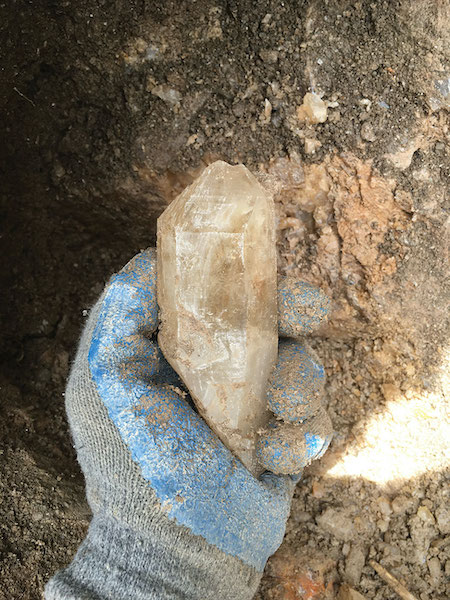
A worthy find at Crystal Peak, photo by Tyler Minnick
Dustin Johnson, owner of Tahoe Rock n Ride, a rock shop in South Lake Tahoe, knows the local crystal varieties well, having sold specimens found by local collectors for the past 12 years.
“Smoky quartz is the most common local crystal and can be found throughout the Tahoe Basin and the Carson Valley,” says Johnson. “There is also carnelian on the North Shore of the lake, and if you look hard enough, you might find some amethyst around here, but that’s really rare.”
Smoky quartz crystals are six-sided hexagonal prisms that are gray to black in color and usually more opaque than translucent. Carnelian differs from standard quartz crystals in that it doesn’t form hexagonal-faceted prisms. It’s a reddish-brown, marble-shaped stone that can be found on the beaches of, you guessed it, Carnelian Bay and Agate Bay on Tahoe’s North Shore.
Amethyst is the highly prized purple quartz crystal varietal. It is one of the most valuable forms of quartz found locally and is what Teter and Anderson are primarily hunting for. After years of searching, the two diggers both mine for amethyst exclusively on private claims, but they learned where to look by driving out dirt roads and checking out the subtle variations in the geology.
“There are endless dirt roads around here and they almost all lead to some kind of mineral deposit,” says Anderson. “That’s how I got started. I just got in the car and started exploring and learning the ropes of how to find minerals. It didn’t take long before I realized that there are cool minerals to be found everywhere.”
While the rocks around Tahoe may all look the same, with a keen eye and a basic understanding about the geologic forces that shaped the Sierra, those on the hunt can find a lot more mineral diversity than what appears on first glance.

The find of a lifetime—a massive amethyst cluster unearthed by Abe Teter, photo by Seth Lightcap
Mother Nature’s Secret Recipe
If you recall from your high school science class, rocks are made from minerals, and minerals are made from elements. Quartz is a mineral composed of two elements—silicon and oxygen—with the chemical formula SIO2, or silica dioxide.
Rocks are classified as sedimentary, igneous or metamorphic based on how the minerals came together to form the rock. Sedimentary rocks, like sandstone, were formed from the layering of sand, shells, pebbles and fragments of organic materials. Igneous rocks, like granite, basalt and pumice, were formed as magma cooled over time. And metamorphic rocks, like slate, were formed as pre-existing rock was subject to intense heat and pressure underground. Quartz crystals most commonly grow in igneous rock, which is the most prevalent rock in the Sierra.
Igneous rocks are further identified as either intrusive or extrusive depending on whether the magma cooled slowly underground or quickly above ground. Granite is an intrusive igneous rock made of three primary minerals—quartz, feldspar and mica—that cooled slowly below the ground. Volcanic rocks, like basalt and pumice, are extrusive igneous rocks that formed very quickly as magma cooled above the ground.
Quartz crystals tend to form at the intersection of intrusive and extrusive igneous rocks where there has been tectonic activity, like earthquakes and mountain formation. The extreme forces of the tectonic plates shifting created underground cracks and cavities within the igneous rock.
As the rock opened up, quartz-rich water seeped through the cracks and into the pockets. These pockets were then pushed to the surface of the earth over millions of years as the mountains rose, slowly cooling as they crept upward. If the quartz-rich water cooled slow enough, the pockets formed the prismatic quartz crystals that people hunt for just below the earth’s surface today. Other pockets cooled too fast for prismatic crystal formation, leaving behind veins of common milky quartz that is opaque and not faceted.
But neither the shifting of the earth’s plates nor crystal growth is a continuous activity. Quartz crystals often grow in short phases during spurts of tectonic activity, which change the rate of cooling or introduce impurities into the quartz-rich water. The purple coloration of amethyst is caused by the introduction of iron and low doses of naturally occurring radiation into the quartz crystalline structure. The radiation emanates from the granite that surrounds the water pockets as they cool. Granite contains trace amounts of uranium, which releases radioactive radon gas. The same causation produces the signature dark smoky quartz crystals found in the Tahoe area, only that is the result of aluminum impurities combined with radiation.
Legally Narrowing the Search
So, what does it all mean? Do you need a geology degree to find a quartz crystal? Not at all.
“Go look for areas with lots of white quartz on the ground,” says Teter. “Once you find white quartz, look at the pieces and see if you can find any with shiny, faceted faces. If you find any faceted pieces, you know that crystallized quartz exists in that area.”
But Teter is also quick to point out that, just because you find white quartz, doesn’t mean you should immediately start digging.
“Before you start prospecting, you must know exactly where you are to make sure that you’re not on a private claim or in a protected area,” he adds. “Digging on a claim without permission or in the wilderness is illegal and can get you in big trouble.”
Both California and Nevada issue mining claims that award the claimant the mineral rights to a specified parcel of public land, typically 20 acres. If a parcel is actively claimed, others are still allowed to access the land, but they are not allowed to dig or remove any minerals without permission. Active claims are usually marked with a sign, but it’s not uncommon for claim-jumpers to tear down the signs.
Regardless of whether the claim is marked, miners can easily avoid digging on active claims by identifying their location online. Thediggings.com is a free map-based website that lists millions of both active and closed claims in the United States.
It is also illegal to dig for minerals in state parks or designated wilderness, which is why longtime local crystal diggers like Tyler Minnick often search outside the confines of the Tahoe Basin.
“I don’t do a lot of collecting in the Tahoe Basin because so much of the Basin is protected,” says Minnick. “If you are just hiking around and you find a floater crystal on the ground, it’s OK to take it, but for what I’m looking for, I’m always doing some pretty heavy excavation, and that’s not allowed.”
To steer clear of private claims and protected land, Minnick and others go to unclaimed public lands on the Nevada side of the Sierra—places like the legendary Crystal Peak near the town of Verdi.
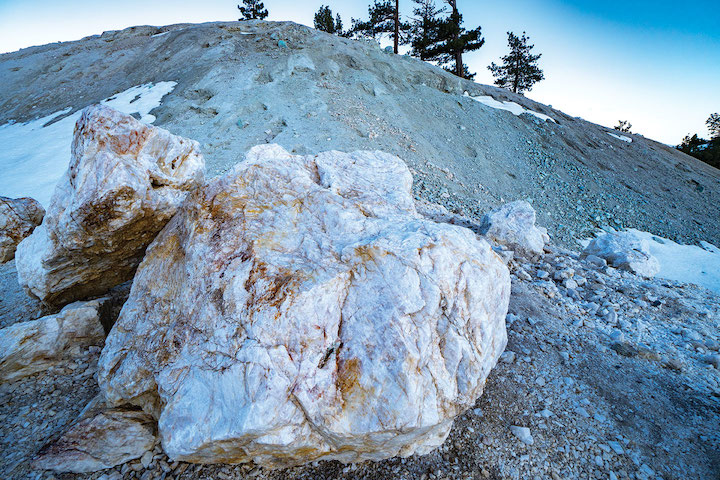
Crystal Peak near Verdi, photo by Seth Lightcap
The Public Crystal Mother Lode
Crystal Peak, located 10 miles outside of Verdi on the eastern slope of the Sierra, is a crystal-hunting location unlike any other in the Tahoe region. What makes the spot so extraordinary is both the quantity of crystals and the peak’s rich mining history.
Geologically, Crystal Peak is a massive quartz knob that contains both thick veins of noncrystalline white quartz and prolific pockets of crystalline quartz. Native Americans collected crystals from the site for millennia before the first recorded visit to the area by pioneer wagon trains in 1845. By 1864, the town of Crystal Peak had sprung up adjacent to the quartz outcrop, spurred by the prospect that the quartz veins might contain gold. No gold was ever found, however, and the town was abandoned starting in 1869 when the Central Pacific Railroad bypassed Crystal Peak to locate the track closer to the Truckee River.

Fresh from the dirt, a double-stacked clear quartz crystal from Crystal Peak, photo by Tyler Minnick
The U.S. Forest Service acquired Crystal Peak in the late 1930s and began mining the optical-grade quartz crystals during World War II for use in two-way radios. Dynamite was used to blast apart the hillside and bring the crystals to the surface. Advances in producing lab-grown quartz crystals rendered the mine obsolete after the war, and only sporadic commercial mining for quartz and silica continued into the 1970s.
The Forest Service repaired the roads leading to Crystal Peak in 1992 and reopened the mine as a public recreation site with an adjacent campground. Small intact crystals can be found within the mines’ substantial tailing piles, but for those who are willing to put in some work, and dig in undisturbed areas, much larger crystals can still be found.
“I’ve spent a lot of time digging on Crystal Peak and found some incredible stuff,” says Minnick. “There’s legends of people finding crystals there back in the day that were so big they couldn’t move them by hand.”
To save some crystals for future generations, only one 5-gallon bucket of quartz is allowed per vehicle per week. Note that the dirt road to the mine is snow-bound during the winter and is best suited for high-clearance vehicles, as it gets rough in a few spots.
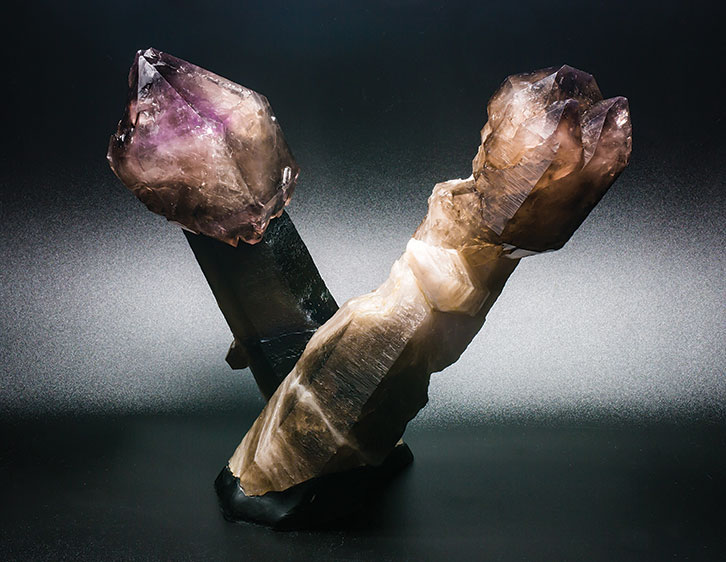
The stunning result of millions of years of crystal growth—a double amethyst scepter from Peterson Mountain, photo by Ryan Anderson
The Private Crystal Mecca
Crystal Peak is not the only well-known crystal hot spot in the area. Magnificent smoky quartz and amethyst crystals have been pulled from the ground at Peterson Mountain on the California-Nevada border near Hallelujah Junction.
In fact, Peterson Mountain has produced world-class crystals over the years—most notably, rare quartz crystal formations called scepters. The caveat is that every square inch of Peterson Mountain is privately claimed, meaning it is illegal to prospect, dig or rockhound anywhere on the mountain.
Anderson and Minnick both know the legal status of crystal mining on Peterson well, as Anderson is a claim owner and Minnick works for Anderson at his claim.
“All crystal-producing areas of Peterson Mountain are claimed and have been claimed for a really long time,” says Minnick. “But there has been a lot of issues over the years with people ripping down the claim signs, so many people go there and don’t realize they are digging on a private claim.”
Adds Anderson: “People are allowed to hike on Peterson Mountain, but they are not allowed to have mining tools, or dig a hole, or even technically pick up a rock and put it in their pocket.”
Anderson, along with four other partners, operate a mining claim on the Nevada side of Peterson Mountain. The claim has been active since the 1980s, and for six to eight weeks every summer they bring heavy machinery to the site to aid in their crystal-mining operations. The partners take on the considerable expense and logistics of bringing in the machinery because of the potential to find prized crystal scepters—quartz formations that can be worth upwards of $20,000 apiece.
“Scepters are an extremely rare quartz formation, and we’ve found some exquisite ones on Peterson that were purple and yellow gem quality,” says Anderson.
Resembling the wand of a medieval king, a quartz scepter has a large crystalline head attached to a long-faceted stem.
“What makes a scepter a scepter is multiple stages of crystalline growth,” Anderson explains. “The stem of the scepter grows in one geological event, and then there was another geological event that introduced a similar combination of fluids and minerals into the cavity that caused a second crystal to grow on top of the stem. If the scepter is amethyst, that means there was a third or even fourth stage of growth where the color came in.”
Finding a gem-quality scepter doesn’t happen every summer, but Anderson and his partners do pull out hundreds of pounds of traditionally shaped amethyst and smoky quartz crystals from Peterson Mountain every year. On a few days each summer, they also offer the opportunity for a handful of non-claim owners to come dig for the day for a fee. The dig fee is not cheap, but people are allowed to keep what they find (Anderson may be contacted via Instagram at @ryanjosephgems).
Unearthing the Treasures
So, you found an area that looks promising for crystals that’s not claimed and is not protected. What to do next? Start digging and keep digging, slowly and carefully.
To find, let alone successfully excavate, a substantial crystal pocket is often incredibly hard work that takes days, if not weeks or months, to complete.
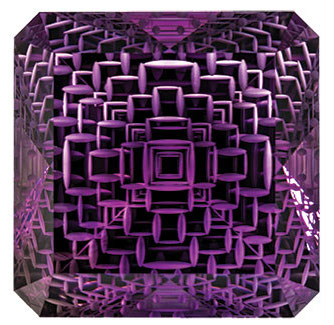
A 174-carat amethyst from Peterson Mountain, found and fantasy cut by Ryan Anderson. The gem now resides in the Smithsonian Natural History Museum, photo by Ryan Anderson
“You might start by finding little pieces of crystals here and there, but it may not be until months or years later that you finally dig deep enough, or chase the minerals up the hill far enough, that you finally hit the crystal pocket,” says Teter.
And once the pocket is found, the most painstaking part of the mining process has only just begun.
“Finding the pocket is only half the battle, or less, honestly,” says Anderson. “Using good pocket-collecting practices is much more important. It’s critical to go slow as you excavate because there could be a $20,000 scepter behind the small crystal you can see, and if you stick a screwdriver or something in there and try to pry it out you could damage the rock behind it.
“And once you damage it, that $20,000 crystal will be worth $5,000, if not less. The only crystals that command the highest prices are flawless—no chips, no dings, no cracks, just perfect the way they grew.”
To guard against damaging the crystals in a pocket, many diggers carefully tease away dirt and debris from around the crystals using a wooden chopstick. The chopstick is pointy enough to remove small pieces of dirt, but it will break before enough pressure is applied to damage a crystal.
A pocket may also look promising initially but fall short of expectations. Finding one crystal doesn’t guarantee there is a treasure trove of crystals deeper in the pocket. Additionally, the crystals may already be broken, having been damaged in an earthquake after they formed.
“You never know what you’re going to find in a pocket,” says Anderson. “It could be nothing, or it could be something groundbreaking. But I love the anticipation that comes from the chase, whether you find something or not.”
Crystal Cheat Codes
So, you still don’t know where to find your first crystal pocket? Never fear. You can always seek help.
“When I first got into rockhounding, I went to the Reno Gem Show and talked to all the locals from the Reno Gem & Mineral Society that had a booth,” says Minnick. “I learned so much. They were all really friendly and a wealth of knowledge.”
The Reno Gem & Mineral Society is a nonprofit organization based out of Sparks that hosts monthly rockhounding field trips and weekly lapidary art and jewelry-making classes. The society also puts on the Jackpot of Gems, a rock show in Reno where society members and professional collectors from around the country sell prized mineral specimens. The next Jackpot of Gems show is slated for September 2021.
Other valuable resources for aspiring crystal hunters are local rockhounding guidebooks. Falcon Guides’ Rockhounding Northern California and Rockhounding Nevada, as well as Gem Guides’ Gem Trails of Northern California and Gem Trails of Nevada, are all highly recommended.
The only caveat to using the guidebooks is that public rockhounding access changes constantly. There are undoubtedly many locations listed that are now privately claimed. But even the out-of-print editions of the books contain details about dozens of collecting sites that have and always will be open to the public. Nevertheless, it’s always important to check a location online before digging.
Smoky Souvenirs
You heard right if it sounds like digging for crystals takes hard work. Veteran crystal hunters will admit to days they spent digging and found nothing. Even a good day may only produce a handful of small crystals. To find a crystal pocket, you either have to get really lucky, or put in some serious time excavating, and also get lucky.
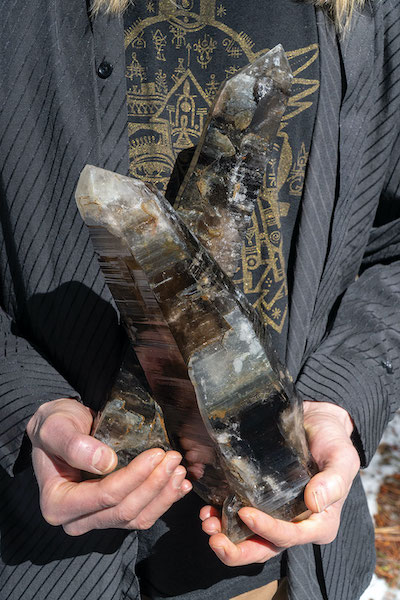
Swords of stone—huge interconnected smoky quartz prisms found by Abe Teter, photo by Seth Lightcap
For those who would like to own a local crystal without the struggle of finding and excavating, look for them for sale at local rock shops. The selection will vary seasonally as local diggers will have more material to sell to the shops in the summer and fall. In South Lake Tahoe, ask for local smoky quartz at Tahoe Rock n Ride. In Truckee and Tahoe City, check for local crystals at New Moon Natural Foods. And in Reno and Virginia City, look for smoky quartz and amethyst from Peterson Mountain at Stone Age Quarry.
Abe Teter, who owns a private claim in the Tahoe region, does occasionally sell prized finds, some of which are set in his custom-made wooden bases. Message him on Instagram at @tahoe_crystal_wizard for details about crystals he has for sale.
Anderson showcases his next-level lapidary art on Instagram at @ryanjosephgems. Many of the amethyst stones he cuts were found on his Peterson Mountain claim. Anderson plans to open a jewelry and gem shop in Graeagle in summer 2021 that will offer lapidary art classes.
Best of luck in the hunt, and remember to always respect the land and the law as you dig. No crystal is worth trashing a protected wilderness area, and stealing crystals from a private claim is a recipe for bad karma that you might never shake.
Seth Lightcap is a writer and photographer from North Tahoe who is fascinated by Sierra geology, and hopes to one day find an amethyst crystal.




Chris Cook
Posted at 17:07h, 18 AprilIs there a way to get permission to walk over the lower slopes of the Halalujah Mtn? I would like to do some surface picking there. I live ed in Reno a long time ago, and I’m 73 now, and I’ll be 74 when we get there.